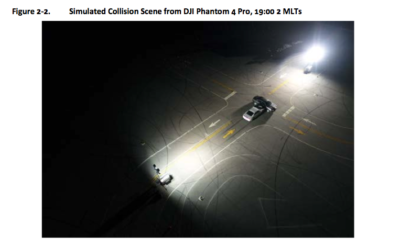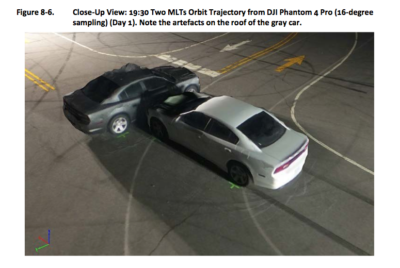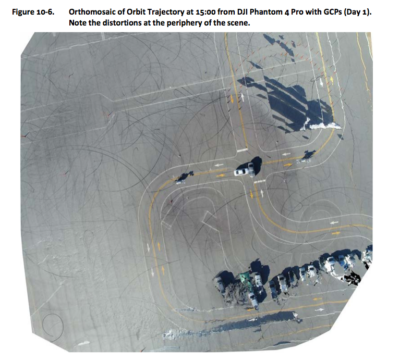
When road collisions occur anywhere in North Carolina, the North Carolina State Highway Patrol (NCSHP) is tasked with investigating the incident as well as clearing the road as quickly as possible. They work with the North Carolina Department of Transportation (NCDOT) to conduct time-sensitive investigations that are focused on gathering and recording critical evidence in a safe, fast, and efficient manner.
Given the potential of drone technology to make just about any task faster, cheaper and safer, stakeholders within the NCSHP realized the impact UAVs could have on this kind of work. However, that potential alone was not enough to compel integration of the technology for tasks such as daylight collision reconstructions. As the agency responsible for helping the NCSHP integrate new technology like drones, the NCDOT knew they needed more information about the efficiencies drones could create, and it’s why they worked with RTI and University of North Carolina at Charlotte (UNC Charlotte) to create a study that would
explore whether or not UAVs could be used to perform low-light collision scene reconstructions.
RTI’s efforts to design a rigorous study, develop new measures of data quality for law enforcement needs, and conduct scientific field studies allowed them to make some specific recommendations to the NCDOT around where and how the department could effectively utilize drones. Their
full report contains a plethora of critical information around how the NCDOT could effectively integrate drone technology into certain standard operating procedures (SOPs). Their results are important from a broader perspective though, since they showcase a model around how research can accelerate the adoption and integration of UAV technology into SOPs across a variety of industries.

Image from the final report prepared by RTI International for the North Carolina Department of Transportation.
is an independent, nonprofit institute that provides research, development, and technical services to government and commercial clients worldwide. They conduct research in a number of different
practice areas that range from health to energy research. Their rigorous efforts allow them to provide their clients with science-based solutions and conclusions that drive decisions around how to move forward.
Drones have provided RTI with an opportunity to test the limits of an exciting new technology that continues to evolve, but they’ve been faced with unique challenges in doing so. The enthusiasm of the market as a whole has compelled some to move forward with drone integration without the data or understanding of how a UAV can fit into an established SOP. It’s just part of the reason that people like Joe Eyerman are focused on validating the claims of the industry with robust studies that are ultimately designed to expedite the integration process.
“Why do I keep doing the research? Because I see it making a difference everyday,” said Eyerman, a senior director for UAS Reseach in the RTI Center for Data Sciences and co-founder of the Black Channel initiative to use clinical research methods to develop drones for public safety. “I do the research because I believe in drone technology. The research is leading us in the right direction, and I think the technology has a lot of promise. However, it's not ready for full-scale applications in most cases yet. Some cases are closer than others, and those are the ones we should start with and do the optimization studies to find the right fit, combination of equipment, sensors, aircraft, software, etc. in order to meet the needs of the end users. The optimization studies should be followed by efficacy studies to determine if the drones actually add value to the first responder mission.”
Eyerman and his co-authors prepared the final report for the NCDOT which found significant benefits and advantages that drone technology offered for low-light collision reconstruction. It also identified that low light conditions posed a unique hurdle. In determining what conditions drones are suitable for producing low-light collision reconstructions, the RTI team explained exactly where and how drones could create value for this specific application and become part of their established SOPs. It helped create a practical approach to drone adoption for the NCDOT.
These results highlight the importance of this type of research since they showcase what it can mean to create a definitive roadmap around how the technology can make an impact in other industries and applications.

Image from the final report prepared by RTI International for the North Carolina Department of Transportation.
The NCDOT study provided an ideal means to determine how drones could be effectively utilized in a real-world application because there were a limited number of variables in it. It’s an important distinction, especially when compared to research with a more diverse set of end users, with inherently more complex challenges, such as search and rescue. Finding a missing person is very difficult because of variables like terrain changes, weather conditions and the skill of an operator, just to name a few. It’s an application that is inherently more challenging and requires more work, but it’s also indicative of why this research is so essential.
False and inflated claims about UAVs can burn budgets and in the case of search and rescue cost lives, which is why this research is critical when it comes to supplanting or supporting what is in most a cases a gold standard SOP that has taken decades to develop. Many understand the importance of research, but that might simply compel them to participate in a confirmatory study, where the testing isn’t always fair, and success isn’t rigorously defined. Luckily, not everyone is moving forward with these types of studies that have foregone conclusions.
“There are some key thought leaders who really understand why we need to do rigorous studies, thorough optimization, and precise efficacy studies,” Eyerman told Commercial UAV News. “One of those people is Romeo Durscher, and he's been working with RTI and others to do randomized control trials since 2015. In fact, some of those studies produced results that he wasn’t expecting, and that provided him with a better understanding of how to move forward. Most people appreciate the value once we get a chance to really show them why they need to do this, but there's a huge amount of work that needs to be done. That’s not just with the research itself, but with things like regulation and defining end user needs. And of course, all of that needs to be done in a world where the technology changes every three months..”
The success that drone visionaries like Romeo have been able to showcase for public safety officials when it comes to everything from dealing with flooding to locating missing people in snow covered mountains are the results of rigorous research like the NCDOT study. They provide researches with test conditions that highlight why it’s so important to define the research question, clearly outline the specific use case, and carefully measure things that haven't been measured before.
While the NCDOT study provides specific insight for any DOT interested in lowlight collision reconstruction, it has also created a guide around the type of rigorous research that needs to be conducted before drones can be adopted into any SOP. Further details around these application specific and industry wide perspectives are just part of what Eyerman is set to talk through during his presentation at the upcoming
DJI AirWorks event.

Image from the final report prepared by RTI International for the North Carolina Department of Transportation.
Regardless of how an individual or organization is using drones, SOPs that utilize drones in just about any manner are still very new, and it’s why the approach to integration based on research that Eyerman is set to showcase at AirWorks is so critical. RTI’s methods borrow from the best in field research methods, and that includes the clinical research field, which is one of the most scrutinized by regulatory agencies. In coming up with models that satisfy the requirements of the FDA, Eyerman and his team are familiar with what it means to create standards that are designed to meet the highest regulatory requirements in the world.
Because drones are so new, Eyerman and his team have had to define the proper reporting mechanisms, proper evaluation techniques and come up with the correct designs for doing the evaluations. Their NCDOT study is set to be a baseline for further research that will take their findings to the next level. Anybody that wants to understand the kind of approach that can define the effective integration of drone technology will be interested in his presentation. However, different audiences will be able to take away different things from it.
“Specifically, the greatest value is going to be for someone engaged in crime scene reconstruction,” said Eyerman. “There are quite a few public safety units across the country, and traffic accident reconstruction happens usually at the highway patrol level, but they are also implemented by the larger law enforcement offices within each state. So you might have 10-15 per state that are tasked with that, and if you take that and scale it, you're talking about a very large number of public safety entities in the United States who are dealing with this issue. Many of them are rapidly developing and adopting the drone for this purpose. The insights I’m going to talk through about our report should help them with that process.”
Ultimately though, the presentation at AirWorks, as well as the report itself, will be of great interest to anybody who is considering adopting drones for any purpose. By taking the DJI Phantom 4 Pro and the DJI Mavic Pro and comparing them in such rigorous detail, the RTI team has laid out what it means to test and provide specifications around where and how these solutions can be integrated into SOPs in a variety of applications.
By and large, we know drones are going to work, but how do we know they matter? That insight is what Eyerman is focused on showcasing for the drone industry as a whole.
Learn more about Eyerman’s work as well as a variety of other fascinating ways drones are being used to reshape the public safety sector at the upcoming DJI AirWorks event in Dallas, Texas on October 30th – November 1st  When road collisions occur anywhere in North Carolina, the North Carolina State Highway Patrol (NCSHP) is tasked with investigating the incident as well as clearing the road as quickly as possible. They work with the North Carolina Department of Transportation (NCDOT) to conduct time-sensitive investigations that are focused on gathering and recording critical evidence in a safe, fast, and efficient manner.Given the potential of drone technology to make just about any task faster, cheaper and safer, stakeholders within the NCSHP realized the impact UAVs could have on this kind of work. However, that potential alone was not enough to compel integration of the technology for tasks such as daylight collision reconstructions. As the agency responsible for helping the NCSHP integrate new technology like drones, the NCDOT knew they needed more information about the efficiencies drones could create, and it’s why they worked with RTI and University of North Carolina at Charlotte (UNC Charlotte) to create a study that would explore whether or not UAVs could be used to perform low-light collision scene reconstructions.RTI’s efforts to design a rigorous study, develop new measures of data quality for law enforcement needs, and conduct scientific field studies allowed them to make some specific recommendations to the NCDOT around where and how the department could effectively utilize drones. Their full report contains a plethora of critical information around how the NCDOT could effectively integrate drone technology into certain standard operating procedures (SOPs). Their results are important from a broader perspective though, since they showcase a model around how research can accelerate the adoption and integration of UAV technology into SOPs across a variety of industries.
When road collisions occur anywhere in North Carolina, the North Carolina State Highway Patrol (NCSHP) is tasked with investigating the incident as well as clearing the road as quickly as possible. They work with the North Carolina Department of Transportation (NCDOT) to conduct time-sensitive investigations that are focused on gathering and recording critical evidence in a safe, fast, and efficient manner.Given the potential of drone technology to make just about any task faster, cheaper and safer, stakeholders within the NCSHP realized the impact UAVs could have on this kind of work. However, that potential alone was not enough to compel integration of the technology for tasks such as daylight collision reconstructions. As the agency responsible for helping the NCSHP integrate new technology like drones, the NCDOT knew they needed more information about the efficiencies drones could create, and it’s why they worked with RTI and University of North Carolina at Charlotte (UNC Charlotte) to create a study that would explore whether or not UAVs could be used to perform low-light collision scene reconstructions.RTI’s efforts to design a rigorous study, develop new measures of data quality for law enforcement needs, and conduct scientific field studies allowed them to make some specific recommendations to the NCDOT around where and how the department could effectively utilize drones. Their full report contains a plethora of critical information around how the NCDOT could effectively integrate drone technology into certain standard operating procedures (SOPs). Their results are important from a broader perspective though, since they showcase a model around how research can accelerate the adoption and integration of UAV technology into SOPs across a variety of industries. 


















Comments